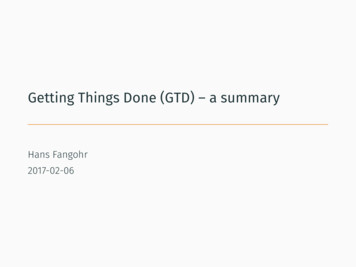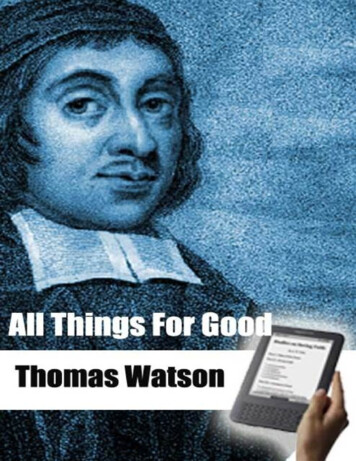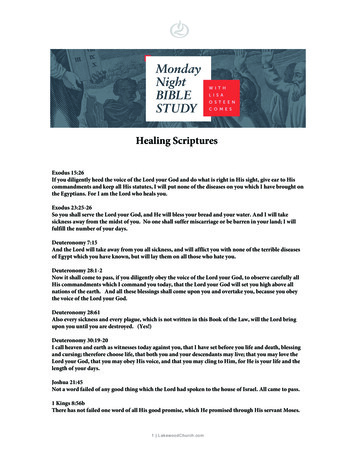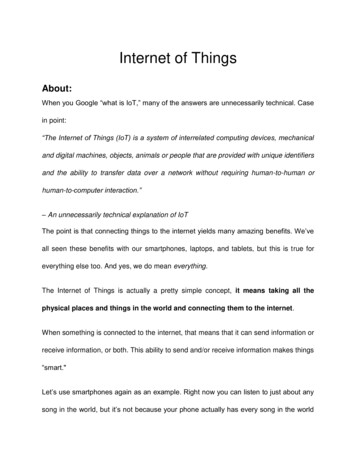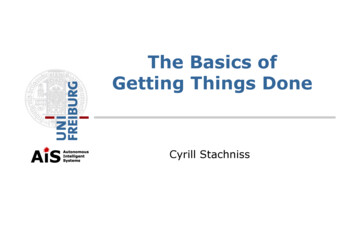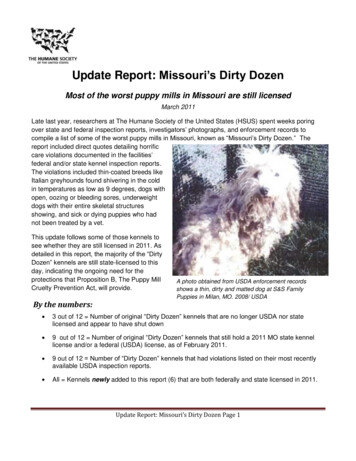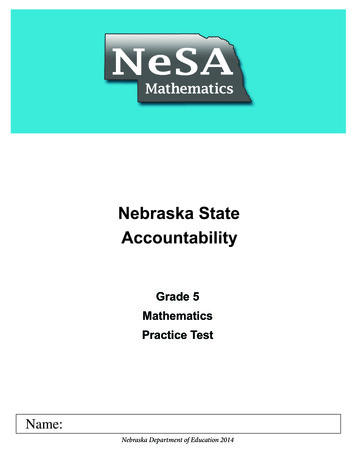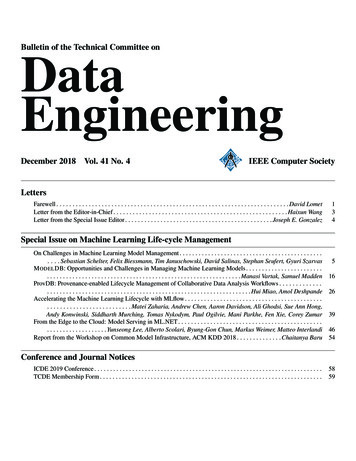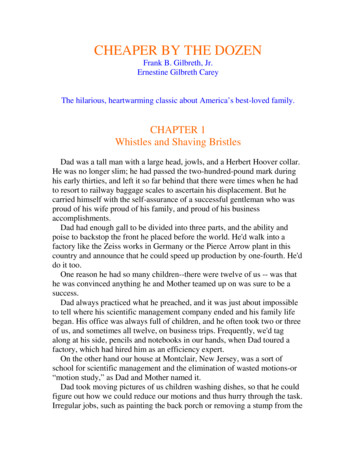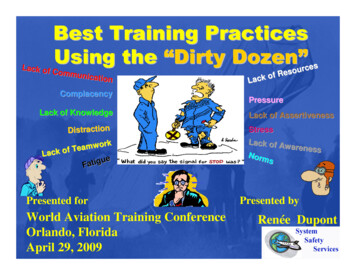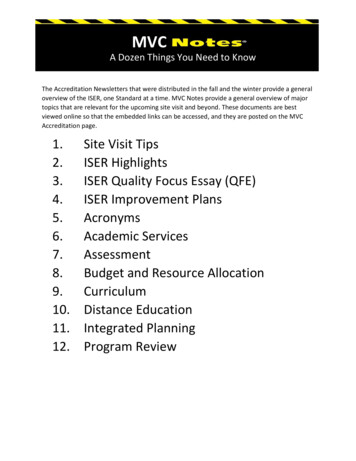
Transcription
MVCA Dozen Things You Need to KnowThe Accreditation Newsletters that were distributed in the fall and the winter provide a generaloverview of the ISER, one Standard at a time. MVC Notes provide a general overview of majortopics that are relevant for the upcoming site visit and beyond. These documents are bestviewed online so that the embedded links can be accessed, and they are posted on the MVCAccreditation page.1.2.3.4.5.6.7.8.9.10.11.12.Site Visit TipsISER HighlightsISER Quality Focus Essay (QFE)ISER Improvement PlansAcronymsAcademic ServicesAssessmentBudget and Resource AllocationCurriculumDistance EducationIntegrated PlanningProgram Review
MVCSite Visit Tips1. Review the areas of the Institutional Self-Evaluation Report that are most relevant to your role atthe college, including the supporting evidence. Use Control F to search the document. The team willwant to hear about your work and your experience at the college in your own words, so you do notneed to memorize or quote directly. You should know how your department, program, division, oroffice was described and analyzed and what evidence was used to draw conclusions about how theCollege meets accreditation standards.2. Gather additional evidence that relates to the standards most relevant to your role at the college.The ISER is supported by over 1,000 documents gathered over the last eighteen months, and as thework of the College has continued, additional information related to statements in the ISER haslikely been collected in reports and other documents. Members of the visiting team may ask for thisinformation, so have it handy. Showing a process is important, but showing assessment of a processand resulting improvement through the process is ideal.3. Familiarize yourself with the new mission statement. Our focus on providing excellent educationalopportunities to the community has not changed; however, the new statement and goals moreclearly capture the broad range of programs, services, and people at Moreno Valley College.4. Highlight what YOU and OTHERS do that makes Moreno Valley College a great place. The ISERwould have to triple in length to include all the ways faculty, classified professionals, managers,administrators, and students contribute to MVC. During the site visit, please feel free to showcasewhat you do in your office, classroom, or work area.5. Ask now if you have questions about something written in the ISER so that you feel confident inyour understanding should the visiting team ask. Having said that, if you are asked a question thatyou cannot answer, offer to find someone who can. Contact Accreditation Liaison Officer, CarlosLopez, or Accreditation Faculty Co-Chair, Sara Nafzgar, if you need assistance with this.6. Keep up the good work! During the site visit, team members will visit places on campus to confirminformation provided in the ISER and supporting evidence. It is not necessary to stop what you aredoing to interact with team members, just give a quick greeting and get back to being amazing. Theyare here to observe the college in action and to get a complete picture of what we do.7. Attend the open session and closing forum to welcome and meet the team. 8. Dr. Rowena Tomaneng, President at San Jose City CollegeMs. Kuni Hay, Vice President of Instruction at Berkeley City CollegeGohar Momjian, ACCJC Vice PresidentDr. Allison Moore, Professor of Accounting at Los Angeles Southwest CollegeDr. Mia Wood, Assistant Professor at Los Angeles Pierce CollegeDr. Jennifer Vega La Serna, Vice President of Academic Services at College of the SequoiasDr. Ann Wright, Instructor, Biological Sciences at Hartnell CollegeDr. Wendy Stewart, Dean of Counseling and Student Development at MiraCosta CollegeMr. Stevenson Kotton, Vice President Business & Administrative Affairs at College of the Marshall IslandsDr. Mark Sanchez, Assistant Superintendent/VP of Student Services at Cuesta College
MVCISER HighlightsThe Institutional Self Evaluation Report (ISER) does not document all the great work doneat MVC. Likewise, this list of highlights does not capture every pride point of the ISER. Thislist does provide a succinct summary of some of the most exceptional parts of our story.Data to Accomplish the Mission Analyzed Cal Grant data and identified potentially eligible students who did not applyGrew financial aid award amount for students 20% (3.4 million dollars) over the last 2 yearsImprovements in scheduling practices and auto awarding of degrees resulted in 808 more degreesawarded than previous yearStudent Support Services Extended hours/days of many Student Support Services (Library, Financial Aid, Admissions, etc.)Streamlined onboarding process to reduce number of days between application and registrationEnhanced online presence-Grad Guru, Net Tutor, and online financial aid & counseling schedulerEnglish, Math, and ESL Placement and Curriculum Began to adjust placement and curriculum before the mandated changes that came with AB705District collaboration on the co-requisite model to increase student completion of Math, English,and ESL courses in the first yearCollege support of extensive FT and PT faculty training in this areaCommunity Partnerships MoVal Learns program provided 50 CTE students with 250 stipend per month for 8 monthsThe College Promise Program, which provided funds for the first year of tuition, fees andtextbooks; the city’s pledge of 50,000 to pay for the second year of college for MV residentsGrowing participation of local businesses on the CTE Advisory CouncilThe 2019 Career & Technical Education Employment Outcomes Survey (CTEOS) showed that thepreponderance of MVC CTE Grad respondents are employed, working in the same field as theirstudies/training, with a 64% overall change in hourly wages after completing trainingK-12 Partnerships Hosted the 4th annual Educational Summit in 2019 titled “Becoming Student Ready”11% increase in graduates from Val Verde & Moreno Valley Districts coming straight to MVCSignificant growth in the Middle College High School Program, with 33% of the participating seniorsearning one or more associate degree along with their high school diploma
Governance Structure Leadership and Governance survey to gauge committee understanding/recommend improvementOngoing changes to improve processes and align with the district structureMission, Vision, and Values Broad collaboration with students, faculty, staff, and administrators to reviseNew Mission, Vision, and Values is current, memorable, and measurableComprehensive Master Plan The 2019-2030 CMP is constructed through the lens of Guided Pathways and with the goal ofcreating a comprehensive collegeFacilities Master Plan was approved Fall 19; Educational Master Plan approval expected Spring 20Strategic Goals and Institution Set Standards Collaborative effort to set ambitious goals that are aligned with the District goalsInstitution set standards exceed the state’s Vision for Success goalsProgram Review Expanded trainings for assessment and program review so that the process and purpose werebetter understoodIncreased assessment of courses to 97%; more robust reporting and planning in program reviewsConnected the program review process to campus resource request timelinesSurvey Feedback From Students Survey of Entering Student Engagement (SENSE) to assess students’ behaviors in the earliestweeks of college and the institutional practices that affect students during this critical time Community College Survey of Student Engagement (CCSSE) to explore institutional practices andreturning student behaviors that are highly correlated with student learning and retention The National Assessment of Collegiate Campus Climates (NACCC) Survey, through the USC Raceand Equity Center to better understand the racial climate on campusCulturally Responsive Professional Development Training Campus wide coordinated effort to move toward becoming a culturally sustaining institutionFaculty training in culturally responsive pedagogy, classified staff training in culturally responsiveservice, and administrators training in culturally responsive leadershipGuided Pathways Framework Highly collaborative effort with forums and the creation of work groups to address specific goalsGroups envisioning and planning for what would be the “dream team” of student support, whilealso working within the realities of limited space to implement ambitious goals
MVCQuality Focus Essay (QFE) HighlightsThe College has committed itself to ambitious improvement goals outlined in the Quality Focus Essay asArea 1: Redesign of College Academic Structures and Student Support Services&Area 2: Student Learning and Professional Development.Area 1 Goals and Objectives(1) Increase the number of students completing degrees, certificates, and transfer; (2) Increase the numberof students attempting 12 units in the first term; (3) Reduce the number of excess accumulated unitsstudents earn for degree completion; (4) Reduce median time to completion of degrees, certificates, andtransfer; (5) Improve completion rates of transfer-level English and math; and (6) Improve student access tohigher education overall by annual unduplicated headcount.Area 1 ActivitiesSix-School Structure: The proposed school structure includes (1) Science, Technology, Engineering, andMathematics; (2) Visual and Performing Arts; (3) Communication, English, and World Languages; (4) PublicSafety; (5) Humanities, Education, and Social and Behavioral Sciences; and (6) Business and Health andHuman Services.Embed Student Support and Academic Support Services within Schools: The College is designing andimplementing student success teams that will be composed of faculty academic counselors, paraprofessional student success coaches, academic discipline faculty mentors, peer mentors, data coaches,and administrator/classified support staff. The success teams will work in a case management model tosupport all students with a declared major or meta-major within the school. A primary support tool will bethe creation and monitoring of a detailed student educational plan customized for each student.Redesign the Student Application and Onboarding Process with a Career Exploration Emphasis: TheCollege is working to incorporate career exploration software, VitaNavis, during the orientation andmatriculation process for students. In addition, the Guided Pathways workgroup has developed ten fields ofinterest (meta-majors) that group all college degrees and certificates within career-focused areas to assiststudents in choosing an initial pathway. Students who choose a specific degree or certificate pathway willreceive a detailed educational plan that will include the courses they need to complete each term in orderto reach their goal.Complete Program Maps for All College Degree and Certificate Pathways: Program maps were completedfor all Associate Degree for Transfer programs in May 2019 through this process and drafts for all otherdegree and certificate programs were completed during summer 2019.Implement EduNav (Electronic Educational Planning Platform): EduNav is slated to roll out to all studentsin spring 2020, and students will be able to use the tool to plan the shortest path to graduation. The toolwill encourage students to take more units per term without taking unnecessary units while providingAcademic Affairs with enrollment management data so that the right number of sections can be offered onthe days and times that students most need them, supporting improved completion and retention ofstudents.
Area 2 Goals and Objectives(1) Create a college wide professional development structure to recommend professional developmentpriorities based on strategic goals, and (2) Provide active learning opportunities to students by creating anapprenticeship program and promoting use of the iMake Innovation Center.Area 2 ActivitiesiMake Innovation Center: The College opened the iMake Innovation Center, a maker-space, on campusnear the end of fall 2019. This space is intended to provide faculty and students with a space for thecreation of hands-on learning activities in a lab that provides equipment allowing for both additiveand subtractive creation objects. Students and faculty will be able to learn new skillsets to transformeducation from a passive lecture-based experience into an interactive and immersive design-based learningexperience. The lab will open as an MIT certified maker space and is designed to support courses fromacross the curriculum. Specialized curriculum in entrepreneurship, design thinking, and introduction toengineering/STEM are also planned for this space.Apprenticeship Program Creation: Moreno Valley College is in the initial stages of creating anapprenticeship program for students that will provide hands-on learning opportunities for students thatlead directly to employment in better than living wage jobs. The planning for the program will occur during2019-2020 with initial opportunities for students becoming available during 2020-2021. The goal of theapprenticeship program is to focus on nontraditional apprenticeship pathways including cyber defenseoccupations, healthcare occupations, and manufacturing and industrial technology occupations. TheCollege, in partnership with the District, received three years of grant funding, totaling 165,000, throughthe American Association of Community Colleges (AACC) Expanding Community College Apprenticeship(ECCA) grant. This funding, in combination with Strong Workforce funding, will support hiring a full-timeapprenticeship director to meet the grant goal of establishing 450 new apprenticeships during the nextthree years.Professional Development: Professional development in support of the Guided Pathways framework willbe focused on providing training in active based learning and on strategies for eliminating equity gaps. Asnoted above, the iMake Innovation Center will be a focal point on campus for providing professionaldevelopment to faculty and staff in active based learning strategies like project based learning, designthinking, and entrepreneurship. Initial opportunities in the center and on campus will begin during thespring of 2020. Initial focus will be on the possible uses for the center in disciplines across the curriculumwith additional focus on project-based learning and design thinking to begin in 2020-2021. Equity initiativesat Moreno Valley College are deeply embedded within the institution and form a basis for all GuidedPathways work. In order to continue this equity focus, the College has aligned professional developmentduring the 2019-2020 year around culturally responsive pedagogy for faculty, culturally responsive servicefor classified staff, and culturally responsive leadership for administrators. The goal of these efforts is tomove college practices, policies, teaching, and services toward being a culturally responsive and sustaininginstitution. Additional professional development will focus on Open Educational Resources (OER) as a toolto close equity gaps and improve success rates for students overall. Goals for the adoption of OER materialby faculty will be set and include the possibility of the development of one or more zero textbook costdegree pathways (Z-Degree).
MVCImprovement PlansWhile MVC maintains the position that it is in alignment with all standards, in the spirit ofcontinuous improvement, the following 6 improvement plans have been created.Disaggregation of Data by Delivery Mode (Standard I.B.5) The College will include disaggregated data by method of delivery (fully online, hybrid, and face-toface) in program review dashboards for enrollment, success, retention, and completion metrics.Regular Evaluation of College Policies and Practices (I.B.7) The College engages in significant activities to evaluate its existing policies and practice; however,more can be done to improve by examining additional important college policies and practices in aregular cycle of evaluation. Namely, the College will identify additional policies and practices in needof regular evaluation. Currently, these include the local curriculum process, the program review andresource allocation process, and the outcomes and assessment of learning and service areaoutcomes processes. In addition, the methodology and cycle of review for regular evaluation andassessment will be established.Communication and Documentation of Assessment and Evaluation Activities (I.B.8) The College currently engages in significant efforts to communicate the results of assessment andevaluation activities but acknowledges that more can be done to document existing processes thatare evaluated and broadcast any changes as a result of these activities. In order to improve, theCollege will identify those processes that are currently not well-documented on campus by spring2020, develop a communication plan for informing the campus community about the results ofassessment and evaluation activities by spring 2020, and execute this plan beginning fall 2020.Create an Overarching Professional Development Structure at MVC (III.A.14) The College and the District engage in significant activities in providing effective human resources inorder to execute their respective mission; however, one area of improvement for MVC is in theorganization of professional development across all campus constituent groups. As indicated in GoalIV.1 of the 2018-2023 MVC Integrated Strategic Plan, there is a need to create a coordinated collegewide professional development structure and plan. Historically, separate committees or campusentities for each constituent group led professional development. Given these separate entities,professional development was not often coordinated across these groups.Update the College Leadership and Governance Handbook (IV.A.6) The College maintains and updates its Leadership and Governance Handbook; however, the currentdocument does not include governance approval routing for existing plans, policies, or proceduresor a process for determining new plans, processes, or procedures. The College will document thegovernance approval routing of existing plans, processes, and policies as well as creating a processfor the approval routing of new items.Adopt a Regular and Systematic Review of College Governance (IV.A.7) The College is currently engaged in the assessment of college governance structures andcommittees. As part of this effort, the College through the Strategic Planning Council and theStandard IV Subcommittee will create a timeline and cycle for regular assessment and evaluation ofcollege governance committees, structures, and decision-making processes.
MVC/RCCD AcronymsACCJC - Accrediting Commission forCommunity and Junior CollegesACES - Academic Counseling andEducational Support programADT - Associate Degree for TransferAOE - Area of Emphasis (Degree)AP - Administrative ProceduresAPC - Academic Planning CouncilA&R - Admissions and RecordsAS - Academic SenateASCCC - Academic Senate of theCalifornia Community CollegesASMVC - Associated Students of MVCASRCCD - Associated Students ofRiverside Community College DistrictBAM - Budget Allocation ModelBCTC - Ben Clark Training CenterBITS - Business & InformationTechnology DepartmentBIRT - Behavioral Intervention andResource TeamBOT - Board of TrusteesBP - Board PolicyBSI - Basic Skills InitiativeCBOC - Citizens’ Bond OversiteCommitteeCCCCO - California Community CollegesChancellor’s OfficeCCSSE - Community Colleges Survey ofStudent EngagementCEC - California Education CodeCI-D - Course Identification NumberingSystemCMP - Comprehensive Master PlanCOMM - Communications DepartmentCOR - Course Outline of RecordCPR - Comprehensive Program ReviewCPTESL - Computerized Proficiency Testfor ESLCRLA - College Reading and LearningAssociationCSEA - CA School Employees AssociationCTA - California Teachers AssociationCTE - Career & Technical EducationDBAC - District Budget Advisory CouncilDCC - District Curriculum CommitteeDE - Distance EducationDEC - Dental Education CenterDEMC - District Enrollment ManagementCommitteeDOI - Dean of InstructionDSS - Disability Support ServicesDSP - District Strategic PlanDSPC - Dist. Strategic Planning CouncilECE - Early Childhood EducationECEC - Early Childhood Education CenterEEO - Equal Employment OpportunityEOPS - Extended Opportunity Programsand ServicesEMP - Educational Master PlanFLEX - Flexible Calendar ProgramFMP - Facilities Master PlanFMTF - Function Map Task ForceFTE - Full Time EquivalentFTES - Full Time Equivalent StudentFYCP - Five Year Construction PlanFYE - First Year ExperienceFYSS - Foster Youth Support Services(Guardian Scholars)GELO - General Education LearningOutcomeGP - Guided PathwaysHASS - Humanities, Arts & SocialSciences DepartmentHHPS - Health, Human & Public ServicesDepartmentHM - Humanities BuildingHRER - Human Resources and EmployeeRelationsHSCE - High School ConcurrentEnrollmentICC - Inter-Club CouncilIDS - Instructional Department SpecialistIE - Institutional EffectivenessIGETC - Intersegmental GeneralEducation Transfer CurriculumILO - Institutional Learning OutcomeINST - InstructionIOI - Improvement of InstructionIR - Institutional ResearchISP - Integrated Strategic PlanISS - Institutional-Set StandardsJD - Job DescriptionKPI - Key Performance IndicatorsLGA - Local Goal AlignmentLGBTQ - Lesbian, Bisexual, Gay,Transgender, Queer, QuestioningLIB - LibraryLFM - Leading from the MiddleLO - Learning OutcomeLC - Learning CenterLLC - Library Learning CenterMCHS - Middle College High SchoolMOU - Memorandum of UnderstandingMMAP - Multiple Measures AssessmentProjectMVC - Moreno Valley CollegeMVV - Mission, Vision, and ValuesNC - Norco CollegeNOC - Network Operations CenterOEI - Online Education InitiativeOER - Open Educational ResourcesOPEB - Other Postemployment BenefitsPACAH - Program and Course ApprovalHandbookPD - Professional DevelopmentPI - Proportionality IndicesPLO - Program Learning OutcomePR - Program ReviewPSC - Parkside ComplexQFS - Quest for SuccessRCC - Riverside City CollegeRCCD - Riverside Community CollegeDistrictRR - Resource RequestSAO - Service Area OutcomeSAS - Student Academic ServicesSCFF - Student Centered FundingFormulaSCI - Science and Technology BuildingSEA - Student Equity & AchievementSEP - Student Educational PlanSFS - Student Financial ServicesSHPS - Student Health & PsychologicalServicesSI - Supplemental InstructionSLO - Student Learning OutcomeSP - Strategic PlanSPC - Strategic Planning CouncilSS - Student ServicesSSS - Student Support ServicesSSSP - Student Success and SupportProgramsSTEM - Science, Technology, Engineeringand MathSTU - Student Services BuildingSWOT - Strengths, Weaknesses,Opportunities and ThreatsSWP - Strong Workforce ProgramS&K - Science and KinesiologyDepartmentTA - Teaching AssignmentTSS - Technology Support ServicesVFS - Vision for SuccessVPAA - Vice President, Academic AffairsVPBS - Vice President, Business ServicesVPSS - Vice President, Student ServicesVRS - Veterans Resource Center
MVCAcademic Support ServicesServicesTo support learning that is taking place in the classroom, Academic Support Services offers peerassisted study sessions, walk-in tutoring, 1-on-1 tutoring, embedded tutors, supplemental instructionleaders, and online tutoring via NetTutor.com. Computers, printers, and other resources are alsoavailable for student use.One goal of Academic Support Services is for tutors to guide students in personal mastery of materialso that the students feel competent their understanding of a subject. Sometimes, this can occur in asingle visit. Often, mastery requires multiple visits to build a variety of skills. In support of this goal,students can expect help working through attempted homework assignments, finding answers toquestions, and learning study tips and strategies. Students should not expect tutors to edit an entirepaper or complete their assignment for them.SubjectsTutorial Services is a multi-discipline center that offers tutoring in math, chemistry, biology,accounting, languages, physics, psychology, statistics, economics, social sciences, computer science,and humanities. Writing and reading support for all disciplines is provided through the WritingReading Center, and math tutoring for all math courses is offered in the Math Lab. SupplementalInstruction (SI) and Embedded Tutoring (ET) provide in-class and study group support for historicallydifficult courses.Tutorial Services (SAS 202)Mon, Wed, Thurs: 9 am - 5 pmTues: 10 am - 7 pmFri: 9am – 4pmMath Lab Spring (HUM 219)Mon - Thurs: 9 am - 8 pmFri: 10 am - 3 pmSat: 10 am - 1 pmWriting & Reading Center (HUM 219)Mon - Thurs: 9 am - 6 pmFri: 10 am - 3 pmSat: 10 am - 1 pmTutorsStudent and faculty tutors area available in the Learning Center Computer Lab, the Math Lab, and theWriting and Reading Center. Student tutors have completed at least one semester of college coursework, have an overall GPA of 3.0 or higher, have been recommended by faculty, and have contentcompetence evidenced by a grade of “A” or “B” in course(s) they tutor. Additionally, tutors receiveongoing professional development training.Successful VisitThe average cost for 1 hour of 1-on-1 tutoring in CA is 44. Tutoring is FREE for MVC students andMVC 2018 data revealed that students who attended ET and SI sessions exceeded the College’sestablished standard for course success and did better than those who did not attend. To make themost of the opportunity, students should bring their student ID, specific questions, enthusiasm, andany materials related to their assignment that have been provided by the professor.Sources: ence/IIB1 SI-Success SF-18.pdf
MVCAssessmentOngoing, evidence-based assessment at MVC is cyclical and used to document trends and promotecontinuous improvement. It includes Program-level Assessment (PLOs), Course-level Assessment (SLOs),General Education Assessment (GELOs), Institution-level Assessment (ILOs), and Non-InstructionalAssessment (SAOs).Program Learning Outcomes (PLOs) All associate degrees and certificates offered through the College have program learning outcomes. As of fall 2019, 49 of 60 active programs (82%) have program level outcomes assessment results.The majority of college programs have accomplished mapping of SLOs to PLOs, and these mappingsare used to develop assessment activities for program learning outcomes.Student Learning Outcomes (SLOs) Student learning outcomes (SLOs) are the specific observable or measurable results that areexpected subsequent to a learning experience. Classroom assessment is done by individual facultywithin the context of individual classes.An assessment report should be submitted/renewed via Nuventive Improve every year by 9/15 forcourses offered in the spring and summer, or by 2/28 for courses offered in fall and winter.If a course is offered at least once per year, at least one SLO should be assessed annually. If a courseis offered less frequently, at least one SLO should be assessed every time the course is offered. AllSLOs for a course should be assessed every 4 years.As of fall 2019, 490 out of 506 active courses (97%) have assessment results.Workshops and the Course Assessment Training Manual provide detailed instructions.All Department Assessment Reports can be accessed online.General Education Learning Outcomes (GELOs) General education prepares students to be able to demonstrate an understanding of howknowledge is discovered and constructed in the natural sciences, the social and behavioral sciences,the humanities, and language and rationality. Students will understand the methods of inquiry thatunderlie the search for knowledge in these fields. In addition, students will gain demonstrable skillsin four broad interdisciplinary areas: Critical Thinking, Information Competency and TechnologyLiteracy, Communication, Self-Development and Global AwarenessGeneral Education Student Learning Outcomes and related assessments can be accessed online.Institutional Learning Outcomes (ILOs) These outcomes are set by each College.MVC’s Integrated and Applied Learning ILO Reports can be accessed online.Integrated and Applied Learning - Students should be able to synthesize information throughapplication of knowledge, skills and responsibilities to new settings and complex problems.Service Area Outcomes (SAOs) An SAO is a specific statement that describes the benefit that a unit hopes to achieve or the impactthat is a result of work that a unit performs.The Student Services Program Reviews contain Program/Department SAO assessment results.
MVCBudget and Resource AllocationRecent examples of resources allocated that went through the cycle described below include new faculty andstaff positions, computer equipment for the iMAKE Innovation Center, supplies to facilitate the Pop-Up ArtExhibition, support expenditures to host the summer Cyber Camp and Student Services Transfer Fairs, and TSSSoftware upgrades for staff and faculty computer operating systems. RCCD and MVC are implementing a newBudget Allocation Model (BAM) in the FY 20/21 budget that will encourage efficiency and facilitate flexibility inthe college programs.Q1July - Sept.Q2Oct. - Dec.Q3Jan. - Mar.Q4Apr. - June New Fiscal Year begins July 1st Financial Services completes prior year fiscal year-end close District presents Final Budget to Board of Trustees for review & approval College conducts Unit Program Reviews & develops and submits Resource Requests College Leadership shares Approved Budget with College community Management reviews and approves Program Reviews Management reviews and approves Resource Requests Divisional Council reviews and prioritzes Resources Requests Prioritized Resource Request List is presented to the Res
Dr. Allison Moore, Professor of Accounting at Los Angeles Southwest College Dr. Mia Wood, Assistant Professor at Los Angeles Pierce College Dr. Jennifer Vega La Serna, Vice President of Academic Services at College of the Sequoias . courses offered in the spring and summer, or by 2/28 for courses offered in fall and winter.
